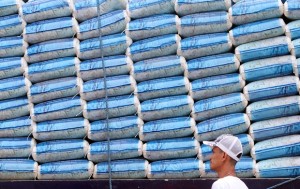DAGUPAN CITY, Philippines—The National Food Authority (NFA) failed to buy palay from farmers in the last harvest season as the agency’s support price of P17 per kilogram could compete with the traders’ buying price of P24 to P25 per kg, provincial officials said.
NFA warehouses in Pangasinan province contained 30,000 bags of buffer rice stocks, all imported from other countries.
“We have no locally produced stocks [because the farmers] have sold [these] to the traders. Even now when harvest time is ending, traders are still buying,” said Dionisio Rivera, NFA administrative officer for western Pangasinan.
The NFA office in western Pangasinan is expecting staggered shipments of 360,000 bags of rice from Vietnam. Its eastern Pangasinan office is expecting 184,000 bags of rice, also from Vietnam.
Rivera said the NFA would not compete with the traders. “We are here to support the farmers. If the traders raise the palay prices, the farmers can [sell to them]. But if the traders drop their prices, the farmers can go back to us. Our role is not to buy all the local produce,” he said.
Last year, the NFA bought palay from local farmers when the traders’ price dropped to P16 per kg, a peso lower than the agency’s buying price.
Rivera said the NFA might not increase its buying price because it would still be passed on to consumers.
“For instance, if we buy palay at P20, we will have to sell at P40 each kilo,” he said. “We have to serve the opposing interests of the producers and the consumers. We buy high, we sell low,” he said.
The NFA sells a 50-kg bag of rice at P1,500, or P30 for each kg. NFA rice is retailed at P32 per kg.
Each consumer can buy only 5 kg at one time so that “we can serve everybody,” said Julieta Orias, assistant provincial manager of NFA eastern Pangasinan.
She said the agency could not sell rice by the bags to consumers to prevent them from reselling it.
Pangasinan is the country’s third-largest rice-producing province next to Nueva Ecija and Isabela provinces.
Pangasinan has surplus production but it “exports to other provinces,” said Dalisay Moya, officer in charge of the office of the provincial agriculturist.
While the price of palay is hurting consumers, it is making farmers happy, despite the high cost of production, she said.
“But the problem is the farmers sell all their produce so that when the lean months come, they become consumers,” she said.–Yolanda Sotelo
